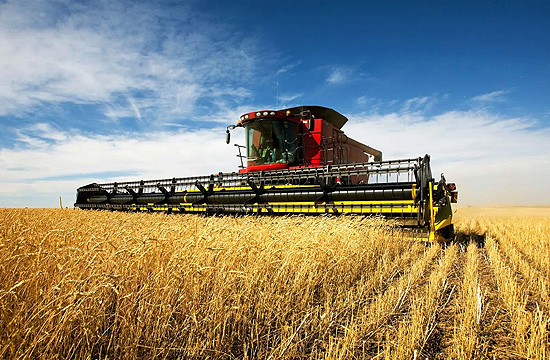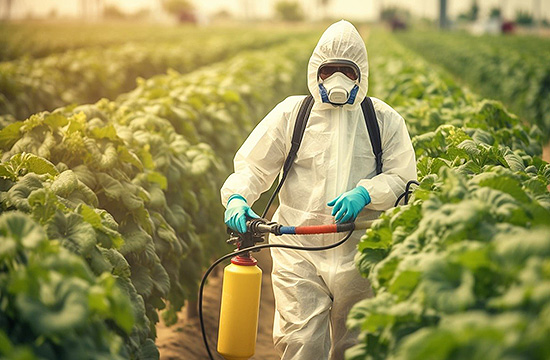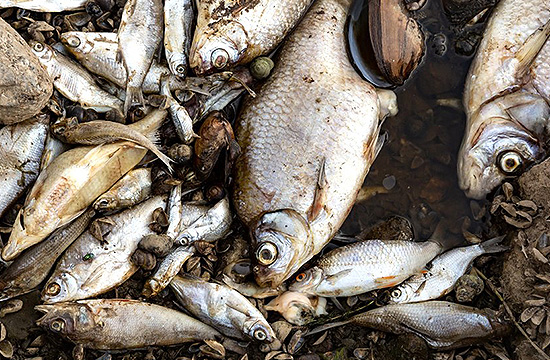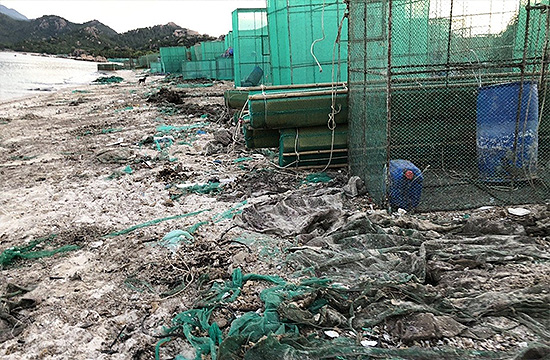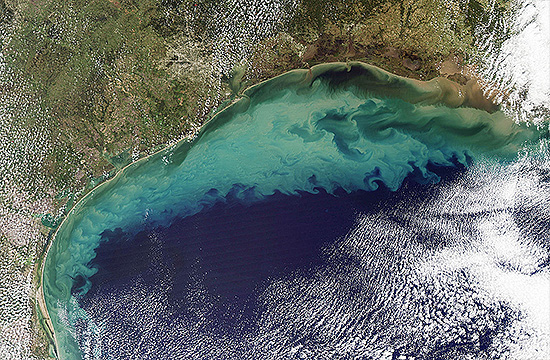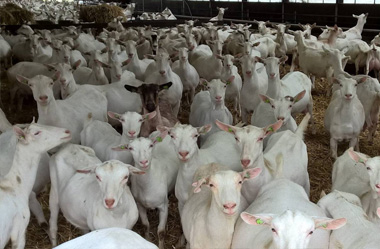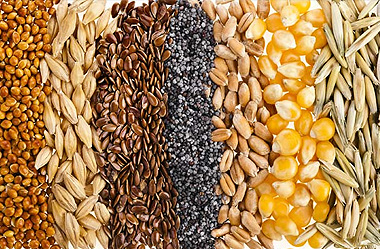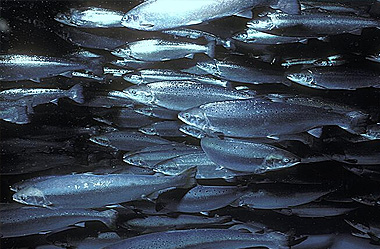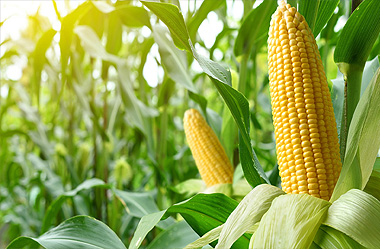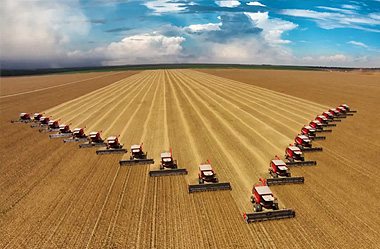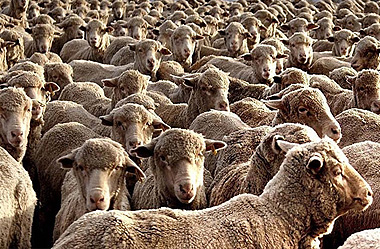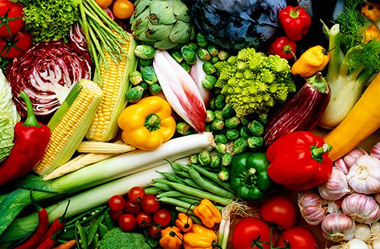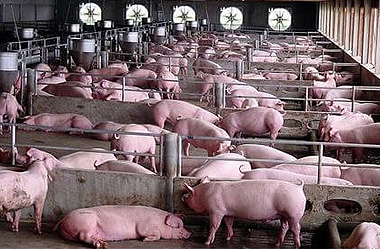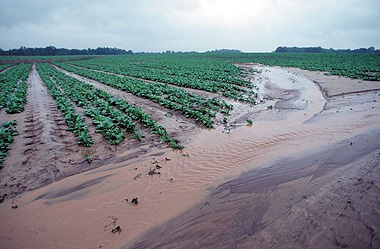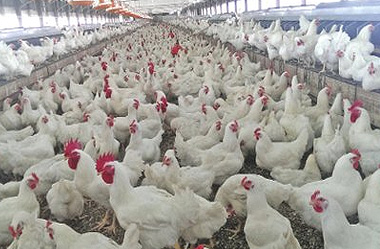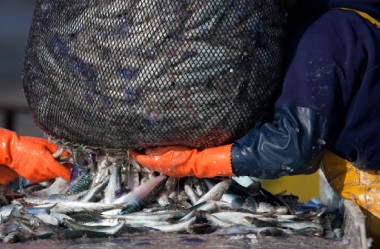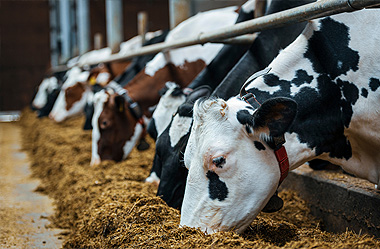- Conventional aquaculture refers to standard farming practices in the aquaculture sector, which may involve using fishmeal (depending on the farmed species), fish oil, antibiotics, and chemicals to prevent disease and enhance growth.
- Scaling up aquaculture operations offers the potential for increased food production, but it's essential to prioritize responsible management. Without proper oversight and sustainable practices, these operations can lead to nutrient runoff, ultimately contributing to eutrophication in surrounding water bodies.
- Eutrophication disrupts habitats and threatens biodiversity, but it can also damage natural carbon sinks and release greenhouse gases (GHGs) into the atmosphere. These released GHGs contribute to the greenhouse effect, trapping heat and causing global warming, a key driver of climate change.
Super-intensive Aquaculture
- Super-intensive aquaculture involves high-stocking densities and relies heavily on artificial feeds, antibiotics, and chemicals to maximize production.
- The intense production methods in super-intensive systems can result in water quality degradation, disease outbreaks, and high nutrient loads in surrounding waters.
- While offering high yields, super-intensive aquaculture shares a similar environmental concern with large-scale aquaculture operations. Due to the high stocking densities, excess nutrients from uneaten feed and fish waste can accumulate in the water.
- Without proper management practices, this can lead to nutrient runoff into surrounding water bodies, ultimately contributing to eutrophication.
- Eutrophication disrupts habitats, threatens biodiversity, damages natural carbon sinks, and contributes to the release of greenhouse gases, accelerating climate change.
Industrialized aquaculture
- High Stocking Density: Fish are densely packed into pens, cages, or ponds to maximize production from a limited amount of space.
Industrialized aquaculture, despite its focus on efficiency, also faces challenges related to nutrient management. - The high stocking density characteristic of many industrial operations can lead to issues similar to those of super-intensive systems.
- Excess nutrients from uneaten feed and fish waste can contribute to nutrient runoff and subsequent eutrophication in nearby water bodies.
- The negative consequences of eutrophication, including habitat destruction, biodiversity loss, greenhouse gas emissions, and contribution to climate change, are equally applicable to industrialized aquaculture practices if not managed sustainably.
Heavy Reliance on External Inputs:
- Fishmeal and Fish Oil: Carnivorous fish species may require significant amounts of fishmeal and oil in their diets, which suggests that they are associated with overfishing and bycatch practices.
- Manufactured Feed: Even omnivorous and herbivorous fish may be fed manufactured feeds containing grains or soy products, often sourced from industrialized agriculture.
- Antibiotics and Chemicals: These may be used to prevent disease outbreaks and enhance growth in these high-density environments.
- Energy-Intensive Methods: Water filtration, aeration, and other processes can require significant energy to maintain suitable water quality in these dense systems.
- Focus on Profitability: Industrialized aquaculture's primary goal is often to maximize production and profitability, which can potentially compromise environmental sustainability compared to alternative approaches.
Efficiency Between Species: Omnivorous, Herbivorous, Carnivorous
- Different fish species have varying diets, with some being omnivorous (e.g., tilapia), herbivorous (e.g., grass carp), or carnivorous (e.g., salmon & trout).
- Carnivorous Fish: Their bodies require significant protein and fats for growth and development. These nutrients are typically found in higher concentrations in animal-based food sources like fishmeal or small fish. However, producing these animal-based feeds often involves multiple steps in the food chain, making them less energy-efficient overall. This translates to a higher FCR for predatory fish, meaning they require more feed to produce one kilogram of body weight than other types.
- Omnivorous Fish: These fish can utilize both plant and animal-based food sources. They can often derive some protein and fats from plant material, supplementing their needs with smaller animal-based sources. This dietary flexibility allows for potentially lower FCRs compared to strict carnivores.
- Herbivorous Fish: These fish obtain all their necessary nutrients directly from plants. Since they are at the beginning of the food chain, they require less energy input to convert their food into body mass. This makes them the most efficient feeders regarding FCR, needing the least amount of feed to produce one kilogram of body weight.
- Carnivorous species often require fishmeal and fish oil in their diets, leading to concerns about overfishing, habitat destruction, and reliance on wild fish stocks for feed.
- Feed Conversion Ratio (FCR) measures how efficiently an animal converts feed into edible meat. A lower FCR indicates a more efficient animal, requiring less feed to produce a kilogram of body weight.
- Carnivorous Fish and FIFO: While fish generally have lower FCRs than land animals, carnivorous fish like salmon require fishmeal and fish oil in their feed. This creates an environmental cost – the reliance on wild fish populations to produce farmed fish.
- FIFO Ratios: The FIFO ratio helps quantify this usually hidden cost. A lower FIFO ratio indicates a more sustainable practice, meaning less wild fish is needed to produce a kilogram of farmed fish. The provided data shows a positive trend with decreasing FIFO ratios over time.
Fishmeal and Fish Oil Production
- Source: Fishmeal and fish oil are produced by grinding up smaller fish, often caught in wild fisheries specifically for this purpose. This practice targets schooling fish like anchovies, sardines, and menhaden.
Overfishing Concerns
- Unsustainable Harvest: The demand for fishmeal and fish oil can lead to overfishing these forage fish populations. This disrupts the natural food chain and can affect entire marine ecosystems.
- Reduced Food Availability: Overfishing these smaller fish can deprive larger predator fish, marine mammals, and seabirds of their natural food source, impacting their populations.
- Bycatch Issues - Accidental Catch: Fishing gear used to catch forage fish for fishmeal production can also unintentionally capture other marine animals in bycatch. This can include juvenile fish of commercially valuable species, dolphins, sea turtles, and other non-target creatures.
- Mortality Rates: Many animals caught as bycatch are either discarded dead or die after being released with injuries. This contributes to unnecessary waste and disrupts the ecological balance.
- The Bottom Line: The reliance on fishmeal and fish oil in carnivorous fish aquaculture contributes to overfishing and bycatch, posing a threat to the sustainability of fisheries and the health of marine ecosystems.
Links to Industrialized Agriculture:
- Most fish production types can be linked to industrialized agriculture through common challenges such as reliance on chemical inputs, feed from industrial sources, and energy-intensive production methods.
Adverse Effects of Industrialized Agriculture
- Expanding industrialized agriculture poses a significant threat to surrounding ecosystems. These practices can lead to:
- Land degradation includes desertification in some areas and a decline in soil quality.
- Water pollution: Reliance on fertilizers can contribute to nutrient runoff, impacting water quality for aquatic life.
- Habitat disruption: Intensive farming practices disrupt natural habitats, leading to biodiversity loss.
- Climate change: Excessive resource consumption, energy use, and greenhouse gas emissions associated with industrialized agriculture contribute to climate change and environmental degradation.
- Reduced ecosystem resilience: Monoculture farming and reliance on synthetic inputs weaken ecosystems, making them more vulnerable to pests and diseases.
Industrialized agriculture's impact on aquaculture systems exacerbates these adverse effects, highlighting the need for ecological, sustainable, and regenerative practices to protect aquatic ecosystems and ensure a healthy future for fish production and environmental conservation.
Feed Conversion Ratio (FCR)
Farmed animals' Food Conversion Ratio (FCR) determines their environmental impact and eco-efficiency. Animals with a lower FCR require fewer inputs to produce protein, leading to reduced resource consumption, minimized farming activities, and less land use change. This translates to lower degradation, decreased greenhouse gas emissions (GHGs), and reduced harm to natural carbon sinks. Therefore, if a fish exhibits a lower FCR compared to other animals for human consumption, it signifies a potential for improved food security and nutrition with a diminished environmental footprint. Fish with lower FCRs offer a promising avenue for more sustainable protein production than many land animals. However, responsible aquaculture practices are crucial to minimize its environmental impact.
Challenges of Higher FCR in Food Production
-
Land Degradation: Animals with a higher FCR require more feed and resources to produce the same amount of protein, leading to increased agricultural activity and land use. This expansion of agriculture can result in land degradation, including desertification and a decline in soil quality.
-
Water Pollution: Increased reliance on fertilizers and resources to produce animals with a higher FCR can contribute to nutrient runoff. This runoff, laden with agricultural chemicals, can pollute water sources and degrade water quality, posing risks to aquatic ecosystems and biodiversity.
-
Habitat Disruption: Industrialized agriculture practices, driven by animals with higher FCR, often disrupt natural habitats. Intensive farming methods can encroach on ecosystems, destroying habitat, fragmenting it, and causing biodiversity loss.
-
Climate Change Impact: The inefficiency in converting feed into protein in animals with higher FCR results in increased resource consumption, energy use, and greenhouse gas emissions. These activities associated with industrialized agriculture contribute to climate change, further exacerbating environmental degradation and ecosystem disruption.
-
Reduced Ecosystem Resilience: Monoculture farming practices driven by animals with higher FCR weaken ecosystems' resilience. The overreliance on synthetic inputs and practices prioritizing quantity over quality can make ecosystems more vulnerable to pests, diseases, and climate-related stressors, limiting their ability to withstand environmental challenges.
Efficiency levels in food production, mainly influenced by the FCR of farmed animals, represent a critical ecological challenge that demands prompt attention. Addressing inefficiency is paramount for establishing a sustainable and resilient food system that can withstand the impacts of environmental degradation, resource depletion, and compromised food security. Overcoming these challenges is essential for fostering a brighter future for the environment and humanity.
Why Fish Can Be a More Eco-Friendly Protein Source
Regarding environmentally friendly food production, fish can be a champion compared to many land animals. This advantage stems from a concept called the Feed Conversion Ratio (FCR).
Fish are highly efficient creatures, and their efficiency is due to several factors.
-
High Fertility: Fish can lay large numbers of eggs, and many species reproduce several times a year, ensuring a steady supply of new individuals. This high fertility contributes to the efficiency of fish populations in replenishing and sustaining their numbers.
-
Streamlined Body Shape: Fish have a streamlined body shape that allows them to move through water with minimal resistance. This physical adaptation reduces the energy needed for swimming, making fish more efficient swimmers than other aquatic animals. The lower energy expenditure in movement contributes to their overall efficiency.
-
Buoyancy and Reduced Gravity Effect: Fish are adapted to live in water, a medium that reduces the effects of gravity on their bodies. Their natural buoyancy, achieved through air sacs and swim bladders, allows fish to adjust their position in the water column with minimal effort. This buoyancy reduces the energy required for swimming, enabling fish to move quickly and efficiently.
-
Poikilothermic Nature: Fish are poikilothermic, meaning their body temperature varies with the environment, and they do not generate heat to regulate it. This characteristic allows fish to conserve energy that would otherwise be spent on regulating body temperature, directing this energy towards growth, hunting, or reproduction.
-
Utilization of the Entire Water Volume: Fish leverage the three-dimensional volume of water for swimming, feeding, and reproducing. Unlike terrestrial animals that utilize surface area for activities, fish in aquatic environments can access the entire water volume, producing protein more efficiently in a given space.
-
Efficient Respiratory System: Fish possess a highly efficient respiratory system that can extract oxygen from water with minimal energy expenditure. Gills, designed for efficient gas exchange, facilitate oxygen uptake from water, optimizing their respiratory efficiency.
-
Simple Digestive System: Fish have a straightforward digestive system that maximizes nutrient absorption from food with minimal waste. Their short digestive tract and efficient enzymes help break down and utilize nutrients effectively, enhancing their feed conversion into protein.
-
Adaptability: Fish have evolved to live in diverse aquatic environments, showcasing remarkable adaptability. This adaptability allows them to thrive in various conditions, reducing competition for resources and enhancing their efficiency in effectively utilizing environmental resources.
-
Environmental and Nutritional Benefits: Fish are known for their sustainable protein production, efficient use of water resources, lower carbon footprint compared to land animals, and ability to thrive in various ecosystems. Their adaptability and unique characteristics contribute to their efficiency in utilizing resources and producing protein sustainably.
Lower FCR translates to several environmental benefits
-
Reduced Resource Consumption: Less feed translates to a lower demand for crops or other resources to produce that feed. This reduces pressure on agricultural land and lessens the need for land-use change, which can harm ecosystems.
-
Minimized Greenhouse Gas Emissions: Producing less feed reduces greenhouse gas emissions associated with cultivation, processing, and transportation, helping mitigate climate change.
-
Preserved Carbon Sinks: Less land-use change helps protect natural carbon sinks like forests, which are crucial for absorbing atmospheric carbon dioxide.
The Bottom Line: More Protein, Less Impact
Fish with lower FCRs can be a more sustainable source of protein for human consumption. They require fewer resources to produce, leading to less environmental degradation and greenhouse gas emissions. This translates to more nutritious protein with a smaller ecological footprint.
Important Considerations
-
While FCR is a valuable metric, it's not the sole factor. Ecologically sustainable fish farming practices that minimize pollution and habitat impact are also crucial.
-
ECI (Efficiency of Conversion of Ingested Food) is another metric that considers animals' digestion and metabolic efficiency, providing a more comprehensive picture.
-
FIFO expresses the contribution from harvested wild fish used in aquafeed compared with the amount of edible farmed fish as a ratio. The fish used in fishmeal and fish oil production are not used for human consumption, but they contribute to global food production with their use as fishmeal and fish oil in aquafeed.
By understanding these factors, we can make informed choices about the seafood we consume and support practices that promote a healthy planet and a secure food supply.

